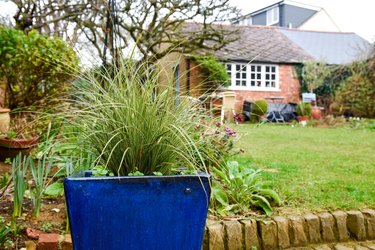
Homeowners spend lots of money and time to build up a nice, thick healthy turf. However, if the weather conditions are right, all that hard work gets diminished. It is a big disappointment to see yesterday's thick turf turn patchy, thin grass.
In most cases, you have a fungal infestation. The trouble is, you have to identify which of the many fungal invaders is the culprit. Examine the grass and identify the symptoms -- then take appropriate action to restore your turf to health.
Video of the Day
Video of the Day
Leaf Spot on Thin Grass
Leaf spot is one of the most common diseases that make grass thin. It likes to strike in spring and fall when the weather is cold and wet and the skies are overcast. Lawns start browning and the grass starts thinning. This is "phase one" of a leaf spot attack. The blades will have small purplish-red or dark brown spots. The spots will get larger and the blades will fade to a straw color.
In the second phase, the fungus penetrates the soil, going for the roots. This is called the "melting out" phase. The grass will get even thinner and melt out the diseased area. To control leaf spot, raise the lawn mower blade so you only cut the top 1/3 of the turf. Cut thatch down so it is no more than ½ inch in height. Eliminate fertilizing until the melt-out phase is complete and the grass is no longer thin.
Stripe Smut Fungus
The fungus that causes stripe smut is Ustilago striiformis. Like leaf spot, it usually occurs when weather is cooler and temperatures are under 50 degrees F. Stripe smut causes grass blades to shred and thin and the turf to look patchy and uneven.
The grass blades will first have yellow-green streaks. Those streaks will turn gray and finally black, and the tips of the blades will curl downward and die. Give the lawn a deep watering early in the day. Watering at night tends to make the problem worse and recovery slower. If the problem is severe, apply benomyl fungicide according to directions.
Powdery Mildew Infection
Powdery mildew can infect shaded lawns in areas with poor air circulation. You can diagnose that the problem is powdery mildew when the grass blades have a substance on the leaves that looks like white powder on grass.
Non-chemical methods of eradicating powdery mildew include aerating the soil, raising the height of the lawnmower blade so you cut no more than the top 1/3 layer of grass, reducing thatch and fertilizing with nitrogen at 1 lb. per one thousand square feet. However, resist the temptation to over-fertilize, as this can create conditions for the powdery mildew to spread.
Anthracnose Leaf Blight
Anthracnose leaf blight is a big problem for both cool- and warm-season turf grasses such as bermudagrass and landscapes with a mixture of different types. Irregular-shaped patches appear in the turf, and the grass gets thin and turns brown, an indication of anthracnose leaf blight; it's caused by the Collectotrichum graminicola fungus.
The "high season" of attack takes place from June through September. Contributing factors include poor irrigation and thatch buildup. Aerate compacted areas, improve irrigation and remove excessive thatch as non-chemical measures. Otherwise, use fungicides such as strobilurins, chlorothalonil, and fludioxonil according to instructions on the container.